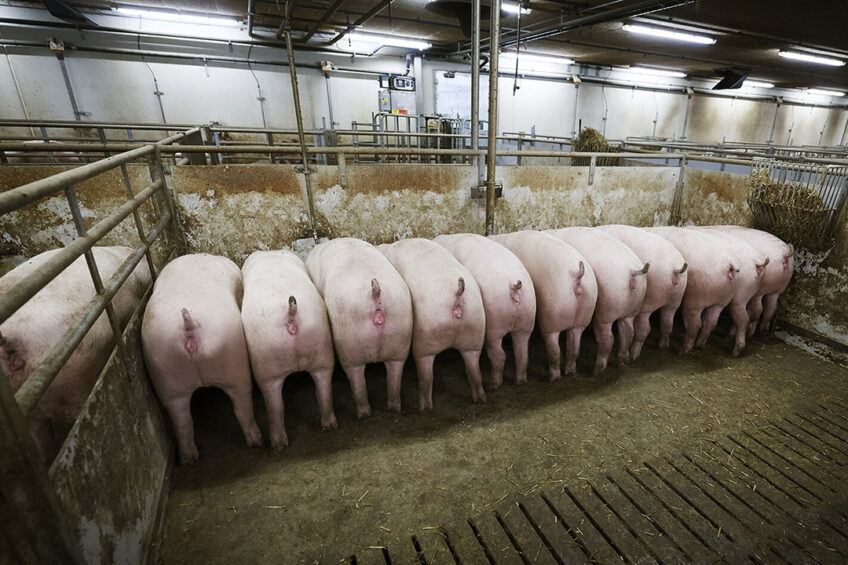From the perfect gilt to a lifetime of performance

A well-timed, tailored feed strategy is everything up to the first insemination, marking the transition from healthy gilt to highly productive sow.
Every highly productive sow starts out as a young gilt. The challenge for farmers is knowing when the time is right for a gilt’s first insemination – and ensuring the animal gets the optimum nutrition to prepare for it. Good decisions at this stage make all the difference to a sow’s farrowing performance throughout life.
Three factors are key – age, weight and back fat thickness prior to insemination. By following an appropriate growth and feeding strategy, farmers can raise uniform gilts with the best possible potential.
The first insemination ideally takes place when the gilt is between 230 and 250 days of age. Weight should be anything from 130 to 155kg. As gilts approach this weight span, adjustment of the feed is necessary to control fat distribution.
Managing growth and wellbeing
The thickness of the gilt’s back fat is particularly critical. According to research, 12 to 15mm of back fat is both an advantage for future longevity as a sow and the ideal thickness for influencing the secretion of leptin – the hormone that stimulates the release of luteinising hormone (LH) and, in turn, the reproductive cycle.
If the gilt is too lean or obese, longevity and productivity are likely to be compromised. A focus on gut health and strength of joints and bones is similarly important to animal performance and wellbeing.
Steps in the feeding strategy
This is where the right feeding strategy with controlled daily weight gain can bring farmers a long way to optimising body composition and overall health.
A daily weight gain of 750 to 800g is the recommended optimum for gilts from a weight of 30kg and up to 140kg prior to insemination. While ad libitum feeding is unproblematic in gilts up to 60kg, feed intake should be limited from then on to obtain the necessary weight gain control (Figure 1). If ad libitum feeding is the only option, however farmers should adjust the feed by lowering the protein content and raising the level of fibre.
From 110kg and up, a reduction in the feed’s digestible protein content can support the growth of back fat deposits and minimise the development of excessive muscle. Several experiments have shown that too high a weight at the first insemination gives a higher percentage of the gilts later exposed too early as sows, partly because a high growth during the growing period increases the risk of osteochondrosis.
The next step in the feeding strategy should be initiated around seven to 14 days before insemination is due to take place. Feed should then be increased to 3.5 to 4kg a day, including a higher protein content to raise plasma levels of LH. Due to this so-called flush feeding, the level of glucose, insulin and estradiol hormone in the blood plasma increase, stimulating the production of eggs.
Figure 1- Recommended daily feed allowance for gilts prior to the first insemination (source: DanBred Feeding Manual).

Click to enlarge figure
Nutritional considerations
At each stage, the best gilt diet is the outcome of multiple considerations, regarding, for example, energy and digestible protein levels, raw material quality, fibre sources and degree of grinding. Accurate addition of minerals and vitamins ensures good bone development and general health. The feed table in Table 1 gives an overview of the recommended feed composition.
Soluble and insoluble fibres are vital to the development and maintenance of a healthy gut – minimising the risk of painful stomach ulcers that compromise productivity and longevity. Sugar beet pulp, lucerne pellets, oats, wheat bran and soybean hulls are all good examples of fibre sources, with barley always the preferred grain component. In an optimum diet, the grain should be semi-rough ground (Table 2).
Tailormade strategies
In practice, all feeding strategies must be developed with a view to local production conditions and limitations. Climate, regional regulations, farm size and equipment, and the availability and quality of raw materials must all be considered. Big differences exist between farms located in countries throughout Europe and Asia, for example.
This is where the skill of an animal nutritionist is the final essential ingredient of every feed strategy. For the best transition from healthy gilt to productive sow, a tailormade feed is the ultimate choice – ensuring the best nutrition at every stage, under all conditions, all over the world.
 Beheer
Beheer





 WP Admin
WP Admin  Bewerk bericht
Bewerk bericht